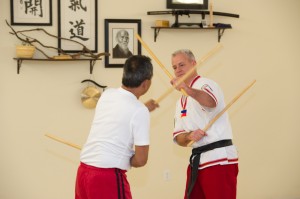 Trecehampas Arnis is a one-or two-stick fighting style. The name, which means “thirteen strikes”, refers to the thirteen basic strikes and defenses, along with disarming and locking techniques.
Trecehampas Arnis is a one-or two-stick fighting style. The name, which means “thirteen strikes”, refers to the thirteen basic strikes and defenses, along with disarming and locking techniques.
There are as many systems or style of Filipino martial arts as there are islands in the Philippines and practitioners living on them. Although the various arts certainly have a number of similarities in their respective training methods and physical application, they can be generally classified into eight categories: provincial styles (e.g., Bicolano Arnis; Pangasinan escrima); personal styles (e.g., Binas dynamic arnis; kali Ilustrisimo); styles defined by technical characteristic (e.g, abaniko style; sinawali style), or fighting range (e.g, serrada escrima; larga mano arnis); styles consisting of composite systems (e.g, Vee arnis jitsu; lameco escrema); eclectic styles (e,g., talahib fighting arts); empty hand systems (e.g., sagasa kick boxing; hagibis combat system), and those styles named after their enemies (e.g., Etalanio style).
When the Spanish invaded the Philippines, the invaders required guns to subdue their fierce opponents. The deadly fighting skills of Filipino warriors nearly overwhelmed them, and they dubbed the native style escrima (skirmish). Escrima was subsequently outlawed, but the techniques did not disappear. They were preserved in secret, sometimes under the very noses of the conquerors, in the form of dances or mock battles staged in religious plays known as moro-moro. These plays featured Filipinos, sometimes costumed as Spanish soldiers wearing Arnes, the harnesses worn during medieval times for armor. The blade fighting forms and footwork were identical to those used in escrima? The word Arnes soon became corrupted to arnis, and the name stuck.
Historically, arnis incorporated three related methods: espada y daga (sword and dagger), which employs a long blade and a short dagger; solo baston (single stick); and sinawali (to weave), which uses two sticks of equal length, twirled in “weaving” fashion for blocking and striking (the term derives from sinawali, the bamboo matting woven in the Philippines).
Dakilang Guro Andy Sanano was fortunate to inherit the family tradition of Trecehampas Arnis, what he considered to be the lost arnis art of his family system. Dakilang Guro Andy Sanano continually teaches Trecehampas Arnis and combines it with his own knowledge of the martial arts, such as karate, combat judo, kung fu and sikaran. Arnis, as Sanano terms the system, incorporates empty hand moves based upon the same motions used in solo baston and sinawali. Sanano system uses low kicks and take-downs for a better-rounded approach.
Dakilang Guro Andy Sanano also insisted on upgrading a particular training aspect traditional in arnis: that of hitting your opponent’s hand or arm instead of his stick; a painful practice that was tolerated because the rattan stick used in arnis were considered sacred. Sanano decided that hitting the stick was just as good a practice method and would obviously discourage far fewer students of arnis, preventing many painful injuries. Sanano does not merely combine techniques; he encourages the individual student to adapt arnis principals to his own sense of feel for each technique. The method should suit the person and not the other way around. This is known simply as using “the feel.”
The feel is for defining the comfortable place where the movements of arnis and the individual human body meets for maximum effectiveness; body and weapon blending to achieve the most natural fighting style based on the individual’s needs and attitude. “Arnis makes martial artists develop and discover new things about their own style.”
A SPECIAL NOTE TO PARENTS
All techniques taught are done with absolute safety in mind. Weapons education and training is done with special care and instruction how not to hurt the student and the partner in the training session. The training is open to adults and children over the age of nine and parental permission is required for anyone under the age of eighteen. Parents of children are most welcome to watch the training sessions.
